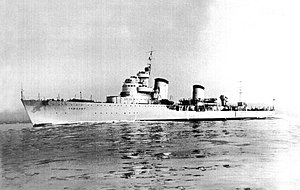 Tashkent on her builder's sea trials, 1937
| |
| Class overview | |
|---|---|
| Name | Tashkent class |
| Operators | |
| Preceded by | Leningrad class |
| Succeeded by | Kiev class |
| Built | 1937–1940 |
| In service | 1940–1942 |
| Planned | 4 |
| Completed | 1 |
| Cancelled | 3 |
| Lost | 1 |
| General characteristics (as designed) | |
| Type | Destroyer leader |
| Displacement | 2,840 long tons (2,890 t) (standard) |
| Length | 139.7 m (458 ft 4 in) (o/a) |
| Beam | 13.7 m (44 ft 11 in) |
| Draft | 3.7 m (12 ft 2 in) |
| Installed power |
|
| Propulsion | 2 shafts; 2 geared steam turbines |
| Speed | 42.7 knots (79.1 km/h; 49.1 mph) |
| Range | 5,030 nmi (9,320 km; 5,790 mi) at 20 knots (37 km/h; 23 mph) |
| Complement | 250 |
| Armament |
|
The Tashkent class (officially known as Project 20) consisted of a single destroyer leader, built in Italy for the Soviet Navy just before World War II. Three others were ordered from shipyards in the Soviet Union, but they were cancelled before they were laid down as they were too difficult to build with the existing technology in Soviet shipyards. Completed in 1939, Tashkent participated in the Sieges of Odessa and Sevastopol in 1941–1942, during which she ferried reinforcements and supplies into those cities, evacuated wounded and refugees, and provided naval gunfire support for Soviet troops. The ship was badly damaged twice by Axis bombers before she was sunk in the harbor in mid-1942. Her wreck refloated in 1944, but it was too badly damaged to be worth repairing and was scrapped after the war.